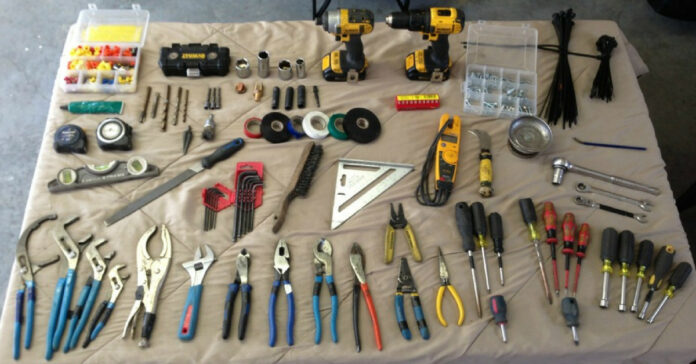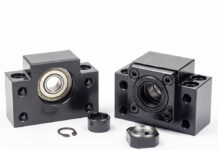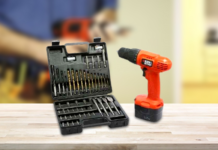Electrical tools are devices that make it easier to perform various tasks, both large and small. They can be used by home and professional artisans alike to help complete tasks more efficiently and with greater accuracy.
These tools can make your work faster and more accurately than traditional hand tools. This is especially true when you need to drill holes or cut materials such as wood or metal in tight spaces where your hands might not fit easily.
For example, drills can make holes in walls or counters for assembling shelving units and other fixtures. Saws can cut through wood and metal materials without causing damage to them, while wrenches can tighten bolts that hold things together.
Additionally, electrical tools can often be adjusted to suit your needs, allowing you to work with more precision and control.
Examples of electrical tools
There are many different types of electrical tools, and they are all used for a wide variety of purposes. Each of these tools is designed to perform specific functions related to working with electric circuits.
Let’s take a closer look at each one below.
Drills
These are used to bore holes in surfaces such as wood or metal, and drills can only work if used with a drill bit.
Manufacturers can make drill bits from various materials, including high-speed steel (HSS), tungsten carbide (TCT), and diamond-tipped ceramic.
Several drill bits are available, each designed for particular applications. They are usually manufactured to exact specifications using machine tools such as CNC lathes and mills.
- Twist Drill
This is the most commonly used type, which has a spiral flute at its end. This bit is typically used for drilling holes in metal or wood and can be either handheld or machine-driven.
- Spade Drill
Another popular type is the spade drill, a flat drill or paddle bit. These bits have straight or twisted shanks and are often used to create large, deep holes in concrete or other hard materials such as stone.
- Core Drill
These are primarily designed for drilling holes into solid materials such as concrete, masonry, and asphalt. They use a hollow cylindrical body with cutting blades on the inside edge that removes material from the sides of the hole as it rotates.
- Wood Auger Bits
These typically have a screw-like design and are used to drill larger holes in wood and other soft materials. So, if you’re looking for high-quality steel drill bits, tungsten carbide drills, or diamond-tipped ceramic ones, look at Standard Electric or your local hardware store.
Screwdrivers
Screwdrivers are used in various applications, including carpentry, plumbing, and electrical work. It’s a tool that is used for tightening or loosening screws.
It consists of a handle and a metal shaft with a tip inserted into the head of the screw. The screwdriver tip is usually made of hardened steel or flat or Phillips-shaped. The handle is typically made of plastic or metal, and it may have a comfortable grip.
Standard Flathead Screwdriver
This is the most common type, which has a flat tip that fits into the slot on the head of the screw.
Phillips-Head Screwdrivers
These have a tip that is grooved with cross-shaped slots. These screwdrivers are commonly used in wood or plastic applications, as the Phillips-head makes it harder to slip than flathead screws.
Star-Tip Screwdriver
This is also known as a Torx screwdriver. This type of screwdriver has six lobes on its tip, which fits into the head of the Torx-style fastener. Star-tip drivers are typically used for electronics and automotive work because they cannot strip out screws like Phillips or flathead types.
Saws
These are tools that consist of a toothed blade used for cutting. These can be used to cut through materials like wood or plastic.
Pliers
These are hand-operated tools used for gripping, bending, and cutting.
Voltage Testers
A voltage tester, also known as a battery tester or multimeter, is an electronic device used to measure the voltage in a circuit.
Devices such as this help test electrical components and systems’ performance, check the status of power supplies, perform diagnostics on batteries, and identify other potential problems.
Voltage testers may be handheld devices that you can plug into standard electrical outlets, or they may feature built-in probes for measuring direct current or alternating current (AC) voltages.
Some voltage testers have additional data logging capabilities and storage options for storing measurements over time.
There are different types of voltage testers available on the market today.
- Basic Digital Multimeter (DMM)
This is the simplest type of voltage tester which can measure both AC and DC voltages. More advanced DMMs may also include features such as a capacitance metre, temperature measurement capabilities, and the ability to measure current.
- Analogue Multimeters (AMM)
An analogue multimeter is an electronic device that uses a galvanometer to measure electrical current, voltage, or resistance.
In addition to measuring the values of these parameters, most analogue multimeters also have other functions such as continuity testing and capacitance measurements.
The basic design of an analogue multimeter consists of a rectifier circuit or set of diodes used to amplify the small amount of current produced by the galvanometer when it is in use. This signal is then fed into an amplifier circuit that controls a pointer on a dial scale.
Different ranges are used depending on what type of measurement needs to be taken. Some specialised versions even include additional features such as input for thermocouples and probes for measuring AC signals.
- Clamp Metres
This type of electrical test equipment is used to measure the current in a wire without making direct contact with the conductor. Clamp metres are typically used by electricians and other professionals who work with electrical systems.
Clamp metres usually have two jaws that open and close around the conductor, allowing them to measure without contacting the live wire. This makes them a safer and better option than traditional multimeters, which require direct contact with the conductor to take a measurement.Most clamp metres also can measure voltage, resistance, and other electrical parameters. Some models even include features like temperature measurement and data logging.
- Insulation Resistance Testers (IRT)
Insulation resistance testers, or IRTs, are specialised devices used to measure the electrical insulation properties of materials such as plastics and rubber.
These devices typically generate a voltage between two test contacts and then measure the resulting current flow due to any leakage. You can then use this measurement to calculate the material’s overall insulation resistance – its ability to block electric current.
There are several different types of IRTs available for use in various applications. For example, some models are designed with delicate electrically-insulating materials like paper and foils.
In contrast, others may be optimised for working with thicker or more rugged materials like metal sheets and cables.
In addition, many IRTs include features like data logging capabilities, which allow users to record and analyse insulation resistance measurements over time.
- Ground Fault Circuit Interrupters (GFCI)
The term “ground fault circuit interrupter,” or GFCI, refers to a type of electrical device designed to detect ground faults and quickly stop the flow of current.
In most cases, this is done by interrupting the power at the source, which effectively shuts off the electricity to prevent dangerous electric shock. Some common examples of GFCIs include electrical outlets, circuit breakers, and wall switches.
GFCIs are widely used in homes, offices, and other buildings as a safety measure to protect against electric shocks. These devices can be installed by homeowners or professional electricians, depending on the particular application needed.
There are several different types of GFCIs available today, including those built directly into appliances and electrical outlets or those that are separate units and installed in the circuit breaker box.
Each type of tester has its advantages and disadvantages, so it is crucial to choose the right one for the job at hand.
When using a voltage tester, it is essential to follow all safety precautions. Before testing, always disconnect any power sources and never work on live circuits. Use only correctly rated fuses, probes, and other devices designed for use with voltage testers, CNC boring mills.
Read the manual carefully before using any new or unfamiliar equipment, and never exceed the maximum voltage or current ratings for the tester.
A voltage tester can be a valuable tool for electricians, technicians, and hobbyists alike with proper care and use.
Final Thoughts
As you can see, many different types of electrical tools can be used in various situations. Whether you’re working on home repairs or industrial construction projects, having the right tools is essential to getting the job done fast.
If you’re starting with electrical work, it’s good to consult with an experienced electrician who can show you how to use these professional-grade tools properly.
With their guidance and support, you’ll be able to handle any electrical project with confidence. And when it comes time to replace old electrical tools or purchase new ones, you’ll have the knowledge and experience needed to make informed buying decisions.
Whether you’re a DIY enthusiast or an industry professional, learning more about electrical tools will help you get the most out of your work. Their many benefits and versatility are essential in any electrical project. So if you’re ready to start working with power tools in your next project, be sure to invest in quality products that won’t let you down. You’ll be glad that you did!


















